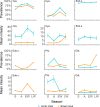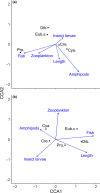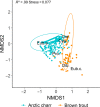Seasonal dietary shifts enhance parasite transmission to lake salmonids during ice cover
- PMID: 32489629
- PMCID: PMC7244800
- DOI: 10.1002/ece3.6173
Seasonal dietary shifts enhance parasite transmission to lake salmonids during ice cover
Abstract
Changes in abiotic and biotic factors between seasons in subarctic lake systems are often profound, potentially affecting the community structure and population dynamics of parasites over the annual cycle. However, few winter studies exist and interactions between fish hosts and their parasites are typically confined to snapshot studies restricted to the summer season whereas host-parasite dynamics during the ice-covered period rarely have been explored. The present study addresses seasonal patterns in the infections of intestinal parasites and their association with the diet of sympatric living Arctic charr (Salvelinus alpinus) and brown trout (Salmo trutta) in Lake Takvatn, a subarctic lake in northern Norway. In total, 354 Arctic charr and 203 brown trout were sampled from the littoral habitat between June 2017 and May 2018. Six trophically transmitted intestinal parasite taxa were identified and quantified, and their seasonal variations were contrasted with dietary information from both stomachs and intestines of the fish. The winter period proved to be an important transmission window for parasites, with increased prevalence and intensity of amphipod-transmitted parasites in Arctic charr and parasites transmitted through fish prey in brown trout. In Arctic charr, seasonal patterns in parasite infections resulted mainly from temporal changes in diet toward amphipods, whereas host body size and the utilization of fish prey were the main drivers in brown trout. The overall dynamics in the community structure of parasites chiefly mirrored the seasonal dietary shifts of their fish hosts.
Keywords: Salmo trutta; Salvelinus alpinus; seasonality; subarctic; winter.
© 2020 The Authors.Ecology and Evolution published by John Wiley & Sons Ltd.
Conflict of interest statement
The authors declare that they have no conflict of interest.
Figures







Similar articles
-
Impacts of ontogenetic dietary shifts on the food-transmitted intestinal parasite communities of two lake salmonids.Int J Parasitol Parasites Wildl. 2020 Jun 10;12:155-164. doi: 10.1016/j.ijppaw.2020.06.002. eCollection 2020 Aug. Int J Parasitol Parasites Wildl. 2020. PMID: 32577375 Free PMC article.
-
Ice-cover effects on competitive interactions between two fish species.J Anim Ecol. 2011 May;80(3):539-47. doi: 10.1111/j.1365-2656.2010.01793.x. Epub 2010 Dec 30. J Anim Ecol. 2011. PMID: 21198589
-
Resource Partitioning in Food, Space and Time between Arctic Charr (Salvelinus alpinus), Brown Trout (Salmo trutta) and European Whitefish (Coregonus lavaretus) at the Southern Edge of Their Continuous Coexistence.PLoS One. 2017 Jan 25;12(1):e0170582. doi: 10.1371/journal.pone.0170582. eCollection 2017. PLoS One. 2017. PMID: 28122061 Free PMC article.
-
Temperature requirements of Atlantic salmon Salmo salar, brown trout Salmo trutta and Arctic charr Salvelinus alpinus: predicting the effects of climate change.J Fish Biol. 2010 Nov;77(8):1793-817. doi: 10.1111/j.1095-8649.2010.02762.x. Epub 2010 Oct 6. J Fish Biol. 2010. PMID: 21078091 Review.
-
Natural resilience in Arctic charr Salvelinus alpinus: life history, spatial and dietary alterations along gradients of interspecific interactions.J Fish Biol. 2014 Jul;85(1):81-118. doi: 10.1111/jfb.12321. Epub 2014 Apr 23. J Fish Biol. 2014. PMID: 24754706 Review.
Cited by
-
High parasite diversity in the amphipod Gammarus lacustris in a subarctic lake.Ecol Evol. 2020 Oct 5;10(21):12385-12394. doi: 10.1002/ece3.6869. eCollection 2020 Nov. Ecol Evol. 2020. PMID: 33209296 Free PMC article.
-
Endoparasitic helminth fauna and diet of Geophagus sveni (Pisces) in Upper Paraná River basin.Parasitol Res. 2024 May 10;123(5):208. doi: 10.1007/s00436-024-08222-0. Parasitol Res. 2024. PMID: 38724709
-
Seasonal Effects on Health Status and Parasitological Traits of an Invasive Minnow in Iberian Waters.Animals (Basel). 2024 May 18;14(10):1502. doi: 10.3390/ani14101502. Animals (Basel). 2024. PMID: 38791719 Free PMC article.
-
Impacts of ontogenetic dietary shifts on the food-transmitted intestinal parasite communities of two lake salmonids.Int J Parasitol Parasites Wildl. 2020 Jun 10;12:155-164. doi: 10.1016/j.ijppaw.2020.06.002. eCollection 2020 Aug. Int J Parasitol Parasites Wildl. 2020. PMID: 32577375 Free PMC article.
-
Temporal dynamics of freshwater planktonic parasites inferred using a DNA metabarcoding time-series.Parasitology. 2021 Nov;148(13):1602-1611. doi: 10.1017/S0031182021001293. Epub 2021 Jul 19. Parasitology. 2021. PMID: 35060465 Free PMC article.
References
-
- Amundsen, P.‐A. (1995). Feeding strategy of Arctic charr (Salvelinus alpinus): General opportunist, but individual specialist. Nordic Journal of Freshwater Research, 71, 150–156.
-
- Amundsen, P.‐A. , & Knudsen, R. (2009). Winter ecology of Arctic charr (Salvelinus alpinus) and brown trout (Salmo trutta) in a subarctic lake, Norway. Aquatic Ecology, 43(3), 765–775. 10.1007/s10452-009-9261-8 - DOI
Associated data
LinkOut - more resources
Full Text Sources
Other Literature Sources

